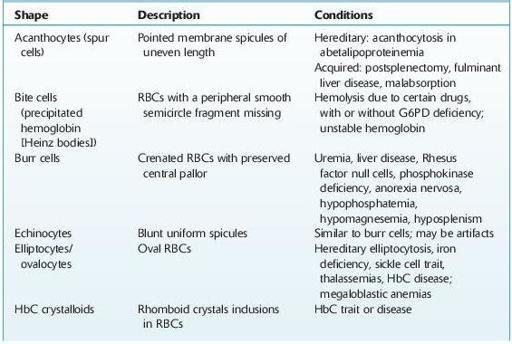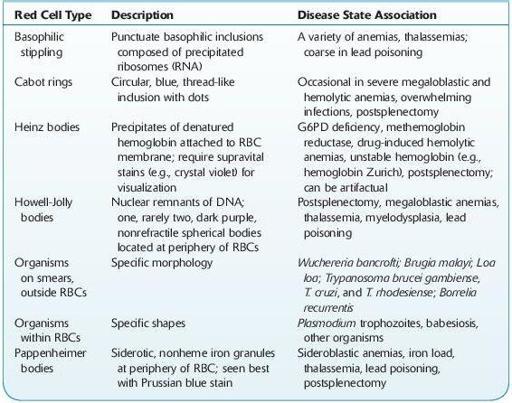Wallach's Interpretation of Diagnostic Tests: Pathways to Arriving at a Clinical Diagnosis (1189 page)
Authors: Mary A. Williamson Mt(ascp) Phd,L. Michael Snyder Md

BOOK: Wallach's Interpretation of Diagnostic Tests: Pathways to Arriving at a Clinical Diagnosis
9.57Mb size Format: txt, pdf, ePub
Interpretation
The RBC count is interpreted in conjunction with red cell indices, hemoglobin, and hematocrit.
Increased In
Certain myeloproliferative neoplasms (e.g., polycythemia vera).
Severe dehydration. RBC counts may be
appropriately
decreased or increased in certain physiologic states.
Decreased In
Various types of anemia
Abnormal RBC Morphology
It is flagged by automated counters, triggering microscopic examination of stained peripheral blood smears (see above).
Abnormalities (see Tables 16.72 and 16.73) may be specific for certain conditions (e.g., spherocytes for hemolytic anemias, sickle cells for sickle cell anemias) or may be informative but not specific.
Anisocytosis
refers to variation in RBC size,
poikilocytosis
refers to variation in shape, and
polychromasia
refers to bluish discoloration of RBC reflecting high reticulocytes.
TABLE 16–72. Abnormal Shapes of Red Blood Cells


TABLE 16–73. Red Blood Cell Inclusions

Limitations
Patient’s circumstances (e.g., vomiting or diarrhea)
Other preanalytic factors
Other books
The Return of the Fallen Angels Book Club (A Hollis Morgan Mystery 3) by R. Franklin James
Falling for Italy by De Ross, Melinda
Green Grass by Raffaella Barker
The Rule of Four by Ian Caldwell, Dustin Thomason
Apocalypticon by Clayton Smith
SAVIOR: A Motorcycle Club Romance by Garland, Fiona
Klingsor's Last Summer by Hermann Hesse
44 Charles Street by Danielle Steel
The Five Deaths of Roxanne Love by Quinn, Erin